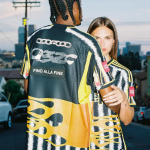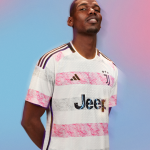
History and aesthetics of the wristband in football
From Materazzi to Adriano, passing through the protests of Pogba and Karimi
March 20th, 2020
In the practice of dressing players there is a detail less luxurious than others, but decidedly in vogue in recent years: the wristband. A silent fashion that began in the early 2000s and stemmed more from aesthetic than practical needs. One of those gadgets that it would be easy to do without, but that many now consider essential, brother of all those decorations of dubious utility such as tights, gloves and ties, that drive crazy quality or particularly whimsical players: Payet, Di Maria, Lautaro, Neymar, David Luiz and others.
One of the precursors of the wristbands was Marco Materazzi, who made it a real trademark at Inter. One on the right and one on the left, for the most important games he had them personalized: from the white ones worn in the 2006 derby won to the Nerazzurri of the Madrid 2010 final, up to the more classic ones, with the names of the three children written above or the national team. Thin terry cuffs, of a completely different thickness compared to tennis ones. In those years he was not the only one to wear them. Another lover of terry wristbands was Tomáš Rosický, who used them at Arsenal in solid colors, at most with red and white stripes: think that Marco Reus years ago elected him his idol and declared that he had copied everything, "even the wristbands".
But that of the terry wristband was a fashion that lasted more or less a decade, a sort of parenthesis in the most long-lived, and still current, history of the adhesive tape wristband: today players use only that. Some say to prevent sprains, others to cover bracelets of particular value: in reality the tape on the wrist is nothing more than a questionable attempt to distinguish it from normal. It is no coincidence that someone like Adriano, the last of the "normal", began to use them with some regularity already in 2002, in Parma, and then made them an indispensable piece for Inter. While Francesco Coco, in the same years, even took them to Spain, to Barcelona.
Born purely for aesthetics, some wristbands have even absorbed a symbolic meaning. Starting in 2006, when Juventus, on their debut in Serie B, took the field with a wristband with a tricolor band, almost as if to claim - not too veiledly - the title taken off the previous year. The image of John Elkann in the stands is emblematic, with the wristband in plain sight even though in shirt.
Three years later the Iranian Ali Karimi - former Bayern Munich player, called "The Asian Maradona" - played against South Korea wearing a green pair, the color symbol of opposition to the regime of the then president Ahmadinejad. Apparently four emissaries from the government asked him to remove them at the end of the first half, but he replied that he did not stand up for one night as a national hero.
The last iconic wristband is the one sported by Paul Pogba in December 2018, in a 4-1 at Bournemouth just after the umpteenth episode of racism in Serie A, starring Kalidou Koulibaly. The Frenchman took the field with a double wristbands, one white and one black, showing the word "NO" in exultation for his goal. An emblematic no to racism, written literally black on white. Stories of wristbands that have become symbols, and not only of aesthetics.














































